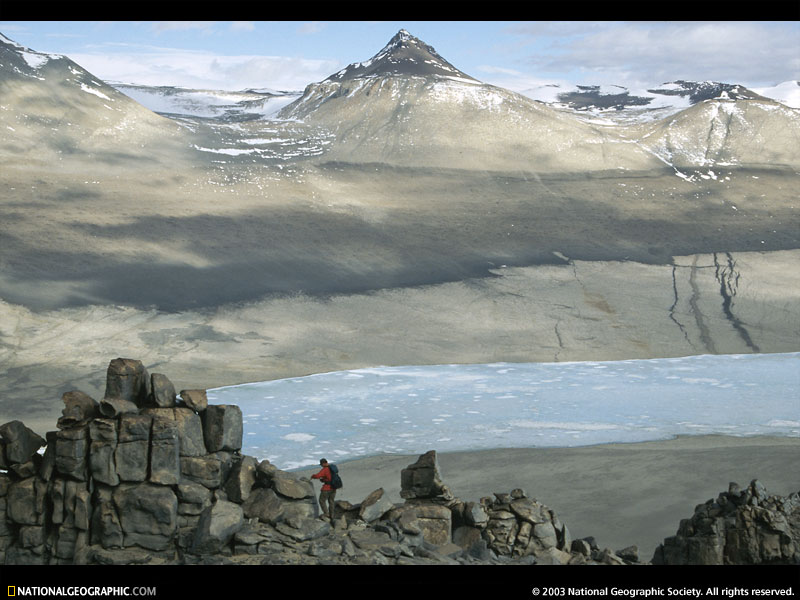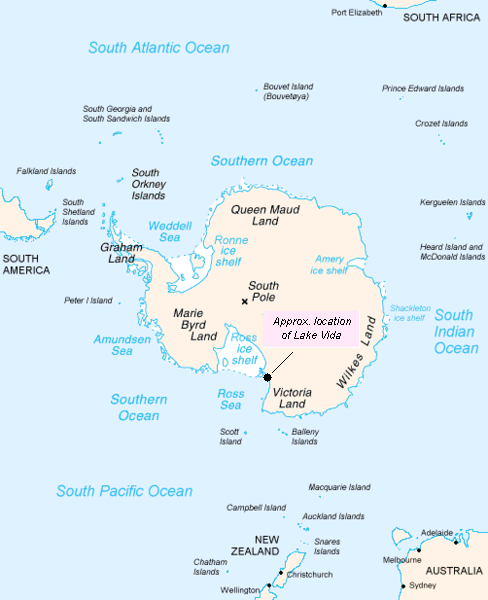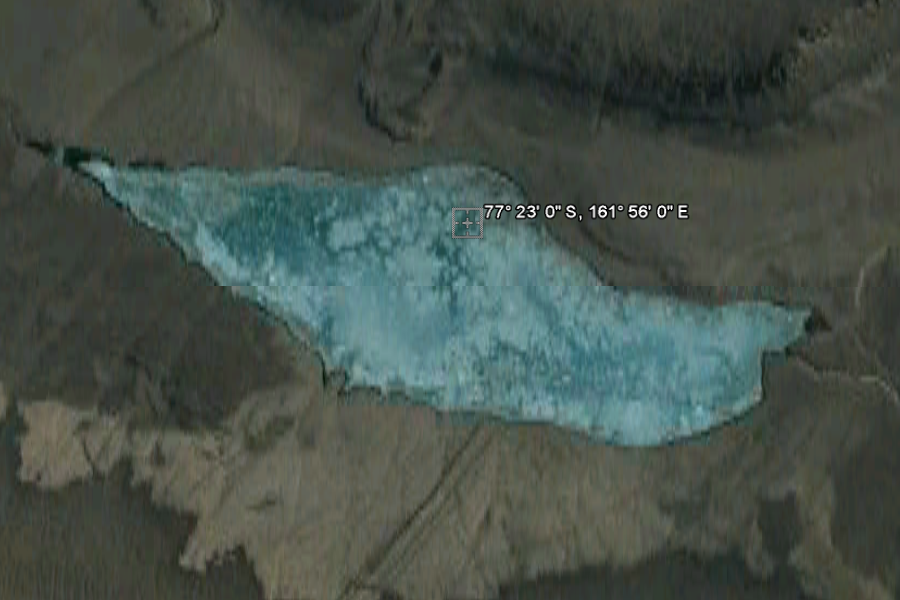|
|
||
|
77° 23' 0" S, 161° 56' 0" E ..
Lake Vida Lake Vida lies in Victoria Valley, the northernmost of the large McMurdo Dry Valleys, on the continent of Antarctica. It is isolated under year-round ice cover, and considerably more saline than seawater. It came to public attention in 2002 when microbes frozen in its ice cover for more than 2,800 years were successfully thawed and reanimated.
Introduction Lake Vida is one of the largest lakes in the McMurdo Dry Valley region and is a closed-basin endorheic lake. The top waters of Lake Vida are frozen year-round to a depth of at least 19 m forming an ice-seal over briny waters that are seven times as saline as seawater[1]. This icecap is the thickest non-glacial ice on earth. The high salinity allow for the lake bottom waters to remain liquid at an average yearly water temperature of -10°C. The ice cap has sealed the saline lake water from external air and water for thousands of years creating a time capsule for ancient DNA. This combination of lake features make Lake Vida a unique lacustrineecosystem on Earth[2]. The lake gained widespread recognition in December 2002 when a research team, led by the University of Illinois at Chicago's Peter Doran, announced the discovery of 2,800 year old halophile microbes (primarily filamentouscyanobacteria) preserved in ice layer core samples drilled in 1996[3]. The microbes reanimated upon thawing, grew and reproduced. Due to this discovery and the freezing mechanisms forming Lake Vida's ice-seal, Lake Vida is now noted as a location for research into Earth's climate and life under extreme conditions, specifically the fauna that could have existed on Mars. The unmanned Lake Vida Meteorological Station monitors conditions around the lake year round for such scientific study[4][5]. The National Science Foundation is funding a new expedition with Peter Doran, his colleague Fabien Kenig, with collaboration from Nevada's Desert Research Institute. The expedition will drill through the ice cap into the brine and lake sediment for core samples. A group from University of Wisconsin will drill for samples, sterilizing the drill to avoid contamination from plastics, rubber, or introduce microbes.[6] The lake itself has no permanent human settlements. The nearby Lake Vida Meteorological Station is unmanned, sending meteorological data to McMurdo Dry Valleys Long Term Ecological Research organization. The closest human settlement is Scott Base McMurdo approximately 125 km away[7]. In addition to the unmanned observation station, a 5-day emergency supply of food for 6 people is cached 600 meters from the southwestern shore[8]. Research teams establish temporary camps from which research activities are conducted on short term basis in the summer months. Hydrology Lake Vida has at least three named inflows, Victoria River, Kite Stream, and Dune Creek. Victoria River passes through the Vida Basin into Victoria Valley, Victoria Land as ephemeralglacial meltwater from the Upper Victoria Glacier, draining from Victoria Upper Lake, seven kilometers to the northwest, to finally drain into the west end of Lake Vida. Kite Stream is also located in the Vida Basin and flows as ephemeral glacial meltwater west from the Victoria Lower Glacier into the east end of Lake Vida. The United States Geological Survey's Atlas of Antarctic Research maps up to nine Lake Vida inflows or outflows including Victoria River and Kite Stream. The inflows and outflows are normally dry due to average annual temperatures down to -30°C at Lake Vida. Meltwater flows for a few weeks in the summer months when temperatures rise sufficiently for the nearby glaciers to melt. The McMurdo Dry Valleys are classified as extreme desert, the area receives less than 10 cm of snowprecipitation a year, this snow builds the nearby glaciers. Geology Main geological features In the vicinity of Lake Vida, a variety of geological features are noted, the most significant being glaciers, lakes, valleys, ridges, and summits. There are approximately 25 named glaciers within a 25 km radius with the nearest being Upper Victoria Glacier, Packard Glacier, Clark Glacier, and Clio Glacier. In the same radius, there are approximately 14 named ridges with the nearest being Robertsons Ridge, Helios Ridge, and Nottage Ridge. In addition to Victoria Valley, there are 16 named valleys with the nearest being Sanford Valley, Barwick Valley and McKelvey Valley. In addition to Upper Victoria Lake that feeds Lake Vida with meltwater, there are approximately 11 other lakes, the nearest being Lake Thomas. The summits around Lake Vida are as follows, Mautino Peak, Mount Saga, Mount Allen, Mount Theseus, Mount Cerberus, Mount Insel, Nickell Peak, and Sponsors Peak. Other geological features Other more minor features include benches, cliffs, gaps, and streams[9]. Sand dunes form between Lake Vida and Lake Victoria. Natural history Kite stream is named after a researcher, James Kite, who found numerous meteorites in the area (1977-1978)[10]. History Lake Vida lies north of Mount Cerberus in the Victoria Valley of Victoria Land. Named by the Victoria University of Wellington Antarctic Expedition (1958-59) after Vida (Vaida), a sledge dog of the Nimrod Expedition, 1910-13[11]. Lake Vida was originally thought to be frozen to the lakebed[12]. Economy Lake Vida has no noted economic features. Any commercial benefits from the scientific expeditions to Lake Vida are indirect. Species lists The following eukaryotespecies have been catalogued within 1 degree[13] of Lake Vida:
|
||
|
77° 23' 0" S, 161° 56' 0" E ..
|
||
| FAIR USE NOTICE: This page contains copyrighted material the use of which has not been specifically authorized by the copyright owner. Pegasus Research Consortium distributes this material without profit to those who have expressed a prior interest in receiving the included information for research and educational purposes. We believe this constitutes a fair use of any such copyrighted material as provided for in 17 U.S.C § 107. If you wish to use copyrighted material from this site for purposes of your own that go beyond fair use, you must obtain permission from the copyright owner. | ||
|
|



